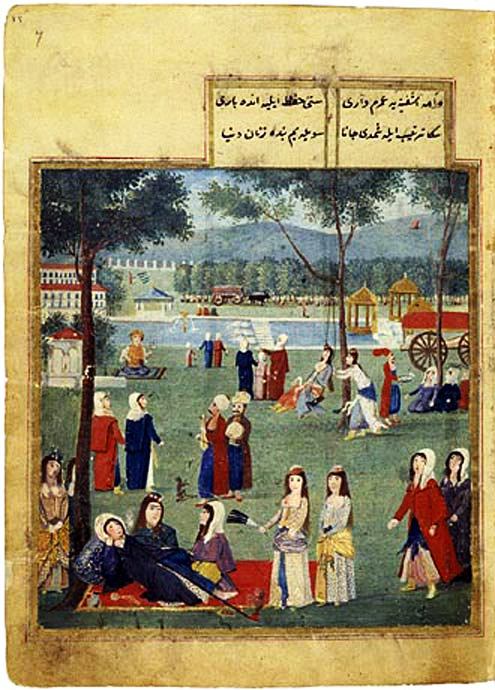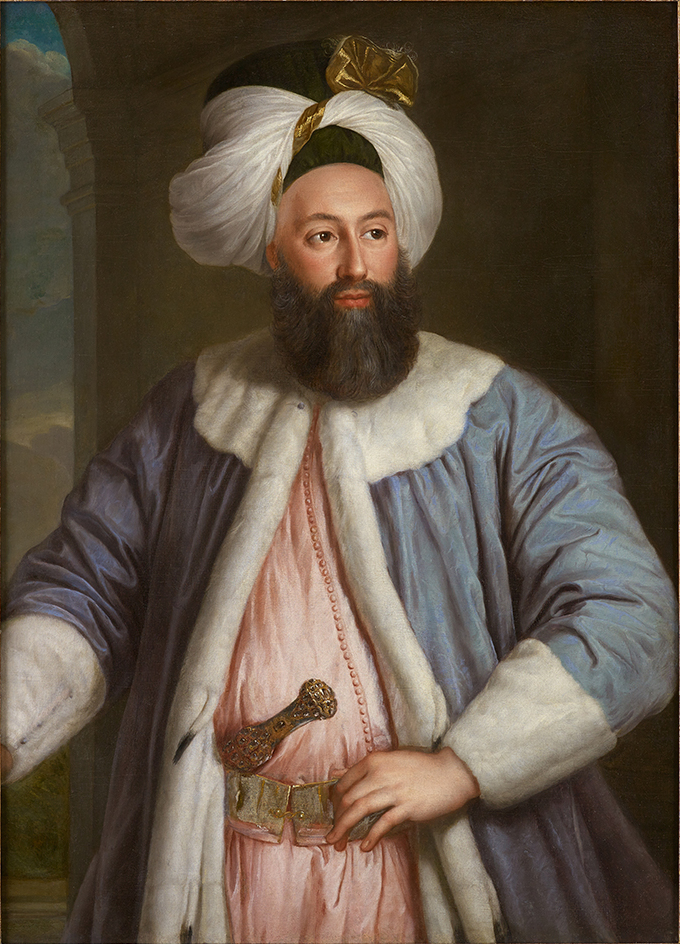|
Tulip Era
The Tulip Period, or Tulip Era (Ottoman Turkish: لاله دورى, tr, Lâle Devri), is a period in Ottoman history from the Treaty of Passarowitz on 21 July 1718 to the Patrona Halil Revolt on 28 September 1730. This was a relatively peaceful period, during which the Ottoman Empire began to orient itself outwards. The name of the period derives from the tulip craze among the Ottoman court society. Cultivating this culturally ambiguous emblem had become a celebrated practice. The tulip period illustrated the conflicts brought by early modern consumer culture. During this period the elite and high-class society of the Ottoman period had established an immense fondness for the tulip, which were utilized in various occasions. Tulips defined nobility and privilege, both in terms of goods and leisure time. The Tulip Period, an era of relative peace and prosperity, saw a rebirth of Ottoman art and architecture (see Tulip Period architecture). During this period, Ottoman publ ... [...More Info...] [...Related Items...] OR: [Wikipedia] [Google] [Baidu] |
Ottoman Turkish Language
Ottoman Turkish ( ota, لِسانِ عُثمانى, Lisân-ı Osmânî, ; tr, Osmanlı Türkçesi) was the standardized register of the Turkish language used by the citizens of the Ottoman Empire (14th to 20th centuries CE). It borrowed extensively, in all aspects, from Arabic and Persian, and its speakers used the Ottoman Turkish alphabet for written communication. During the peak of Ottoman power (), words of foreign origin in Turkish literature in the Ottoman Empire heavily outnumbered native Turkish words, with Arabic and Persian vocabulary accounting for up to 88% of the Ottoman vocabulary in some texts.''Persian Historiography & Geography''Pustaka Nasional Pte Ltd p 69 Consequently, Ottoman Turkish was largely unintelligible to the less-educated lower-class and to rural Turks, who continued to use ("raw/vulgar Turkish"; compare Vulgar Latin and Demotic Greek), which used far fewer foreign loanwords and is the basis of the modern standard. The Tanzimât era (1839–187 ... [...More Info...] [...Related Items...] OR: [Wikipedia] [Google] [Baidu] |
Fountain Of Ahmed III
The Fountain of Sultan Ahmed III ( tr, III. Ahmet Çeşmesi) is a fountain in a Turkish rococo structure in the great square in front of the Imperial Gate of Topkapı Palace in Istanbul, Turkey. It was built under Ottoman sultan Ahmed III in 1728, in the style of the Tulip period. It was a social centre and gathering place during the Ottoman period of Constantinople. History The fountain kiosk of Ahmed III is in the place of a Byzantine fountain known as Perayton. Another fountain, built during the Byzantine Empire stood on the site before this fountain. The architectural features of the exterior reflect a synthesis of traditional Ottoman and contemporary western styles. The fountain was depicted on the reverse of the Turkish 10 lira banknotes of 1947-1952. . Banknote Museum: 4. Emission Group - T ... [...More Info...] [...Related Items...] OR: [Wikipedia] [Google] [Baidu] |
Turkish Airlines
Turkish Airlines ( Turkish: ''Türk Hava Yolları'') is the national flag carrier airline of Turkey. , it operates scheduled services to 340 destinations in Europe, Asia, Africa, and the Americas, making it the largest mainline carrier in the world by number of passenger destinations. The airline serves more destinations non-stop from a single airport than any other airline in the world and flies to 126 countries, more than any other airline. With an operational fleet of 24 cargo aircraft, the airline's cargo division serves 82 destinations. The airline's corporate headquarters are at the Turkish Airlines General Management Building on the grounds of Istanbul Atatürk Airport in Yeşilköy, Bakırköy, Istanbul. Istanbul Airport in Arnavutköy is the airline's main base, and there are secondary hubs at Ankara Esenboğa Airport and İzmir Adnan Menderes Airport. Turkish Airlines has been a member of the Star Alliance network since 1 April 2008. History Early years Turkish Air ... [...More Info...] [...Related Items...] OR: [Wikipedia] [Google] [Baidu] |
Levni Signature
Levni may refer to: *Lev Yilmaz, Levni Yilmaz (born 1973), American independent animated film maker, artist and publisher *Abdulcelil Levni (died 1732), Ottoman Turkish painter and miniaturist *Leuni, an ancient Celtic tribe of Gallaecia {{disambig Turkish-language surnames Turkish masculine given names ... [...More Info...] [...Related Items...] OR: [Wikipedia] [Google] [Baidu] |
Enderûnlu Fâzıl
Enderûnlu Fâzıl (1757–1810) was an Ottoman poet who depicted the beauty of men from various lands of the Ottoman Empire. He achieved fame through his erotic works, which were published posthumously. Among his most famous works is ''The Book of Women'', which was banned in the Ottoman Empire. The book describes the advantages and disadvantages of women from different nations. Life Fâzıl was born in Acre into an Arab family originally of Medina. He spent his early years in Safed in Ottoman Palestine. His grandfather Zahir al-Umar and father Ali Tâhir were both executed (in 1775 and 1776, respectively) for participating in a rebellion. After his father's death, Fâzıl moved to Istanbul. There, he was admitted to the Enderun palace school (taking the name ''Enderuni'' or ''Enderûnlu''), but was expelled in 1783 as a result of his love affairs with other men there. In 1799 he was exiled to Rhodes because of his satirical writings and was only allowed to return to Istanbul ... [...More Info...] [...Related Items...] OR: [Wikipedia] [Google] [Baidu] |
Nedîm
Ahmed Nedîm Efendi (نديم) was the pen name (Ottoman Turkish: ﻡﺨﻠﺺ ''mahlas'') of one of the most celebrated Ottoman poets. He achieved his greatest fame during the reign of Ahmed III, the so-called Tulip Era from 1718 to 1730. He was known for his slightly decadent, even licentious poetry often couched in the most staid of classical formats, but also for bringing the folk poetic forms of ''türkü and şarkı'' into the court.Salzmann, Ariel (2000) "The Age of Tulips: Confluence and Conflict in Early Modern Consumer Culture (1550-1730)" p. 90 ''In'' Quataert, Donald (ed.) (2000) ''Consumption Studies and the History of the Ottoman Empire, 1550-1922: An Introduction'' Albany State University of New York Press, Albany, New York, pp. 83-106, Life Nedim, whose real name was Ahmed (أحمد), was born in Constantinople sometime around the year 1681. His father, Mehmed Efendi, had served as a chief military judge (قاضسکر ''kazasker'') during the reign of the Ottoma ... [...More Info...] [...Related Items...] OR: [Wikipedia] [Google] [Baidu] |
Yirmisekiz Mehmed Çelebi
Yirmisekiz Mehmed Çelebi Efendi (ca. 1670–1732), also Mehmed Efendi (sometimes spelled Mehemet Effendi in France), was an Ottoman statesman who was delegated as ambassador by the Sultan Ahmed III to Louis XV's France in 1720. He is remembered for his account of his embassy mission (a ''sefâretnâme'', "book of embassy"). Yirmisekiz Mehmed Çelebi was born in Edirne to a family of Georgianİsmail Hâmi Danişmend, ''Osmanlı Devlet Erkânı'', Türkiye Yayınevi, İstanbul, 1971, p. 60. descent. His date of birth is unknown. He was the son of an officer in the Janissary corps, Süleyman Ağa, who died during a campaign to Pécs. Mehmed Çelebi himself was enrolled in the Janissary corps, and since he had served in the 28th battalion ("''orta''" in Janissary terminology) of the corps, he came to be known with the nickname ''Yirmisekiz'' ("twenty-eight" in Turkish) for his entire life. His descendants, including his son who became a grand vizier, also carried the name in the ... [...More Info...] [...Related Items...] OR: [Wikipedia] [Google] [Baidu] |
Palace Of Versailles
The Palace of Versailles ( ; french: Château de Versailles ) is a former royal residence built by King Louis XIV located in Versailles, Yvelines, Versailles, about west of Paris, France. The palace is owned by the French Republic and since 1995 has been managed, under the direction of the Ministry of Culture (France), French Ministry of Culture, by the Public Establishment of the Palace, Museum and National Estate of Versailles. Some 15,000,000 people visit the palace, park, or gardens of Versailles every year, making it one of the most popular tourist attractions in the world. Louis XIII built a simple hunting lodge on the site of the Palace of Versailles in 1623 and replaced it with a small château in 1631–34. Louis XIV expanded the château into a palace in several phases from 1661 to 1715. It was a favorite residence for both kings, and in 1682, Louis XIV moved the seat of his court and government to Versailles, making the palace the ''de facto'' capital of France. This ... [...More Info...] [...Related Items...] OR: [Wikipedia] [Google] [Baidu] |
Golden Horn
The Golden Horn ( tr, Altın Boynuz or ''Haliç''; grc, Χρυσόκερας, ''Chrysókeras''; la, Sinus Ceratinus) is a major urban waterway and the primary inlet of the Bosphorus in Istanbul, Turkey. As a natural estuary that connects with the Bosphorus Strait at the point where the strait meets the Sea of Marmara, the waters of the Golden Horn help define the northern boundary of the peninsula constituting "Old Istanbul" (ancient Byzantium and Constantinople), the tip of which is the promontory of Sarayburnu, or Seraglio Point. This estuarial inlet geographically separates the historic center of Istanbul from the rest of the city, and forms a horn-shaped, sheltered harbor that in the course of history has protected Greek, Roman, Byzantine, Ottoman and other maritime trade ships for thousandsBBC: "Istanbul's ... [...More Info...] [...Related Items...] OR: [Wikipedia] [Google] [Baidu] |
Kâğıthane
Kâğıthane (), formerly Sadâbad ( ota, سعدآباد, translit=Sa‘dābād) and Glykà Nerà (Greek language, Greek: Γλυκά Νερά, , 'sweet waters') is a neighbourhood at the far northern end of the Golden Horn on the European side of Istanbul, Turkey. It extends along the shores of the Alibeyköy and Kağıthane rivers that discharge into the Golden Horn. Formerly a working class district, Kağıthane is now part of a major real estate development area. Kağıthane means 'paper house' in Turkish. The area formed part of the popular picnicking area known as the Sweet Waters of Europe. The mayor is Mevlüt Öztekin of the governing Justice and Development Party (Turkey), Ak Parti. Kâğıthane was part of Beyoğlu until 1954 and part of Şişli between 1954 and 1987. Neighbourhoods of Kâğıthane include Seyrantepe, Hamidiye, Çağlayan, Kağıthane, Çağlayan, Merkez (centre) and Gültepe. Kağıthane is served by the metro lines M7 and M11 and Çağlayan served by ... [...More Info...] [...Related Items...] OR: [Wikipedia] [Google] [Baidu] |
Nevşehirli Damat Ibrahim Pasha
Nevşehirli Damat Ibrahim Pasha ( ota, نوشہرلی داماد ابراہیم پاشا 1662 - 1 October 1730) served as Grand Vizier for Sultan Ahmed III of the Ottoman Empire during the Tulip period. He was also the head of a ruling family which had great influence in the court of Ahmed III. The epithet "Nevşehirli" (meaning "from Nevşehir") is used to distinguish this Grand Vizier from another, Damat Ibrahim Pasha (died 1601). Early life He was born in Nevşehir (formerly Muşkara) in 1662, to Sipahi Ali Aga, the voivode of Izdin, and Fatma Hanım. In 1689 he went to Istanbul, to see his relatives and to find a job. Achievements The abilities of Ibrahim, who directed the government from 1718 to 1730, preserved an unusual internal peace in the empire, though the frontier provinces were often the scenes of disorder and revolt. This was repeatedly the case in Egypt and Arabia, and still more frequently in the districts northward and eastward of the Black Sea, especially amo ... [...More Info...] [...Related Items...] OR: [Wikipedia] [Google] [Baidu] |
Edirne
Edirne (, ), formerly known as Adrianople or Hadrianopolis (Greek: Άδριανούπολις), is a city in Turkey, in the northwestern part of the province of Edirne in Eastern Thrace. Situated from the Greek and from the Bulgarian borders, Edirne was the second capital city of the Ottoman Empire from 1369 to 1453, before Constantinople became its capital. The city is a commercial centre for woven textiles, silks, carpets and agricultural products and has a growing tourism industry. In 2019 its estimated population was 185,408. Edirne has an attractive location on the rivers Meriç and Tunca and has managed to withstand some of the unattractive development that mars the outskirts of many Turkish cities. The town is famous in Turkey for its liver. ''Ciğer tava'' (breaded and deep-fried liver) is often served with a side of cacık, a dish of diluted strained yogurt with chopped cucumber. Names and etymology The city was founded and named after the Roman emperor Hadr ... [...More Info...] [...Related Items...] OR: [Wikipedia] [Google] [Baidu] |
.jpg)






